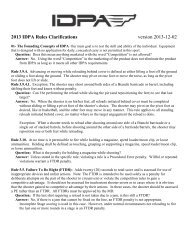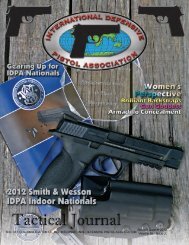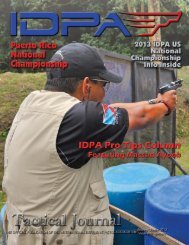Volume: 17, Issue: 1 (1st Quarter 2013) - IDPA.com
Volume: 17, Issue: 1 (1st Quarter 2013) - IDPA.com
Volume: 17, Issue: 1 (1st Quarter 2013) - IDPA.com
You also want an ePaper? Increase the reach of your titles
YUMPU automatically turns print PDFs into web optimized ePapers that Google loves.
SR hooter<br />
eady<br />
Letters to the Tactical Journal<br />
Strike a Balance<br />
While first reading “Easier Does<br />
It” by Thomas Pinney, I found myself<br />
rolling my eyes wondering if he really<br />
thought shuffling around the same four<br />
targets in an open field was the essence<br />
of the perfect COF for a match. I know<br />
that, even as a mediocre shooter, I often<br />
travel up to five hours on a given Sunday<br />
in order to <strong>com</strong>pete at more challenging<br />
matches and pass by the nearer<br />
club which actually sets up six stages in<br />
two bays by shuffling around the same<br />
number of targets in each bay.<br />
But there is merit to his idea and I<br />
submit the ‘Citrus Challenge’ at CFRPC<br />
in Orlando as an example. This annually<br />
sanctioned, fall match, incorporated<br />
10 COF’s with more than 120 shooters<br />
and finished the day by 3 p.m. No bay<br />
had more than 2 movers; there were no<br />
marathon sprints and no belly flopping,<br />
although there were a couple of low<br />
cover situations required. The trade off<br />
was that half the stages required three<br />
shots each but, at least, it succeeded in<br />
getting away from the ‘6 shot-move’<br />
groupings which seem to haunt every<br />
match. A half minute in total time separated<br />
the first from the 10th shooter and<br />
more than 2 minutes stood between the<br />
first and the middle contestant, plenty of<br />
time difference between the best and the<br />
rest.<br />
There wasn’t as much ‘buzz’ about the<br />
stages as say, the Georgia State Match<br />
with a myriad of elaborate pneumatic<br />
movers, but even Georgia needed a<br />
quarter of its stages to be three shots<br />
each. In the real world there are lots<br />
of things in the way, everything continuously<br />
moves and you usually have<br />
immediate feedback if you hit an opponent.<br />
But this is a <strong>com</strong>petitive game, not<br />
defensive training. Remembering that<br />
shooters are seeking both as we <strong>com</strong>pete<br />
creates the best matches.<br />
Randall Milan-Williams A37273<br />
The Tactical Journal wel<strong>com</strong>es letters<br />
to the editor for “Shooter Ready”.<br />
Send your letters to “Shooter Ready” <strong>IDPA</strong><br />
2232 CR 719<br />
Berryville, AR 72616<br />
Email: editor@idpa.<strong>com</strong><br />
I believe that the key is striking a<br />
balance. Quick shoot’em ups, long field<br />
courses, <strong>com</strong>plicated props, open field<br />
of targets, long movement and stand<br />
and fight. You need all of these to make<br />
a good <strong>IDPA</strong> match. So sometimes a<br />
single club match may get unbalanced<br />
one way or the other but the next match<br />
should go back the other way. This<br />
leads to fresh ideas and ways of looking<br />
at things and thus better stages and<br />
continued exciting matches. The key<br />
is not getting pulled too far one way<br />
or the other and especially not mistaking<br />
gimmicks as shortcut to keeping a<br />
match challenging and entertaining.<br />
Editor<br />
New Trick<br />
The Central Carolinas Shooting Club<br />
recently held a classifier using the system<br />
described in <strong>Volume</strong> 16-2 of the<br />
Tactical Journal and it was a great success.<br />
Not only did it shorten the overall<br />
time to shoot the classifier but there<br />
were additional benefits. The workload<br />
on the Safety Officers was reduced,<br />
each shooter had a chance to look at<br />
their targets before pasting and the faster<br />
pace kept everyone involved. Kudos<br />
to the Ontelaunee Rod & Gun Club for<br />
this great idea.<br />
Ben Lochary A37490<br />
I am always looking for a way to<br />
speed things up without sacrificing<br />
quality. I’ll be using this at our next<br />
classifier as well and lend my voice<br />
to Ontelaunee for passing the idea<br />
around.<br />
Editor<br />
Everyone Wins<br />
Two years ago I had no desire to pick<br />
up a gun but when my dear husband<br />
purchased a home defense firearm he<br />
insisted that I learn to use it. So with<br />
much fear and trepidation I allowed<br />
him to drag me onto the shooting range.<br />
Even with his training, I was very<br />
un<strong>com</strong>fortable handling a gun, so he<br />
went with me to the NRA Basic Pistol<br />
course which I highly re<strong>com</strong>mend to<br />
anyone wanting to understand all the<br />
aspects of safely handling a firearm. (I<br />
was the only woman in the class and my<br />
husband was the envy of all the other<br />
husbands there!) While at the class they<br />
took us to the range and helped us learn<br />
to shoot. One of the instructors was a<br />
woman, older than I am, and a bulls-eye<br />
shooter. I was inspired!<br />
I was a 2-sport college athlete, but<br />
after having four children and dealing<br />
with a couple of life’s curve balls,<br />
at age 50-something I doubted that<br />
there would ever be any chance for me<br />
to participate in a fast paced <strong>com</strong>petitive<br />
sport again. I had accepted that I<br />
would have to be satisfied with my glory<br />
days from college and my more recent<br />
ac<strong>com</strong>plishment-Candyland champion.<br />
As I began shooting I discovered that in<br />
many ways it was similar to basketballputting<br />
a round object through a small<br />
hole-and that many of the breathing and<br />
sight acquisition skills I needed were<br />
already innate from my college sports<br />
training. Something started to awaken<br />
in me. For Christmas I asked for a .22<br />
pistol and Santa (my dear husband) left<br />
me one under the tree. I spent all winter<br />
and spring at the range plinking away.<br />
I also got used to shooting the home<br />
defense firearm and my fear of the “big<br />
bang” and the recoil began to dissipate<br />
as I worked on grip, trigger pull and<br />
shooting stance.<br />
Shortly after this my husband obtained<br />
a license to carry and we soon<br />
realized that our home defense system<br />
(my dear hubby and his gun) was not<br />
always home when I was, so he bought<br />
me a <strong>com</strong>pact pistol to have at my disposal.<br />
The .22 soon started gathering<br />
dust because I discovered that 9mm was<br />
much more fun! (And again, my dear<br />
husband encouraged me with plenty of<br />
(Continued on page 28)<br />
Letters should be typewritten<br />
but legible handwriting is<br />
acceptable. Letters must be less<br />
than 350 words. We reserve the<br />
right to edit all published letters<br />
for clarity and length.<br />
<strong>IDPA</strong> Tactical Journal First <strong>Quarter</strong> <strong>2013</strong> 3








